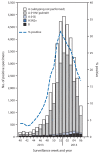Update: influenza activity - United States, September 29, 2013-February 8, 2014
- PMID: 24553198
- PMCID: PMC4584759
Update: influenza activity - United States, September 29, 2013-February 8, 2014
Abstract
Influenza activity in the United States began to increase in mid-November and remained elevated through February 8, 2014. During that time, influenza A (H1N1)pdm09 (pH1N1) viruses predominated overall, while few B and A (H3N2) viruses were detected. This report summarizes U.S. influenza activity* during September 29, 2013-February 8, 2014, and updates the previous summary.
Figures




References
-
- Jhung MA, Swerdlow D, Olsen SJ, et al. Epidemiology of 2009 pandemic influenza A (H1N1) in the United States. Clin Infect Dis. 2011;52(Suppl 1):S13–26. - PubMed
-
- CDC. FluView: influenza-associated hospitalizations. Atlanta, GA: US Department of Health and Human Services, CDC; 2014. Available at http://www.cdc.gov/flu/weekly.
-
- Hancock K, Veguilla V, Xiuhua L, et al. Cross-reactive antibody responses to the 2009 pandemic H1N1 influenza virus. N Engl J Med. 2009;361:1945–52. - PubMed
-
- CDC. FluVaxView. Atlanta, GA: US Department of Health and Human Services, CDC; 2014. Available at http://www.cdc.gov/flu/fluvaxview.
MeSH terms
LinkOut - more resources
Full Text Sources
Medical

